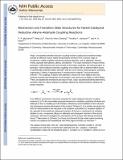Mechanism and Transition-State Structures for Nickel-Catalyzed Reductive Alkyne−Aldehyde Coupling Reactions
Author(s)
McCarren, Patrick R.; Liu, Peng; Cheong, Paul Ha-Yeon; Jamison, Timothy F.; Houk, K. N.
DownloadJamison_Mechanism and transition.pdf (1.423Mb)
PUBLISHER_POLICY
Publisher Policy
Article is made available in accordance with the publisher's policy and may be subject to US copyright law. Please refer to the publisher's site for terms of use.
Terms of use
Metadata
Show full item recordAbstract
The mechanism of nickel-catalyzed reductive alkyne−aldehyde coupling reactions has been investigated using density functional theory. The preferred mechanism involves oxidative cyclization to form the nickeladihydrofuran intermediate followed by transmetalation and reductive elimination. The rate- and selectivity-determining oxidative cyclization transition state is analyzed in detail. The d → π* back-donation stabilizes the transition state and leads to higher reactivity for alkynes than alkenes. Strong Lewis acids accelerate the couplings with both alkynes and alkenes by coordinating with the aldehyde oxygen in the transition state.
Date issued
2009-04Department
Massachusetts Institute of Technology. Department of ChemistryJournal
Journal of the American Chemical Society
Publisher
American Chemical Society (ACS)
Citation
McCarren, P. R., Peng Liu, Paul Ha-Yeon Cheong, Timothy F. Jamison, and K. N. Houk. “Mechanism and Transition-State Structures for Nickel-Catalyzed Reductive Alkyne−Aldehyde Coupling Reactions.” Journal of the American Chemical Society 131, no. 19 (May 20, 2009): 6654-6655.
Version: Author's final manuscript
ISSN
0002-7863
1520-5126